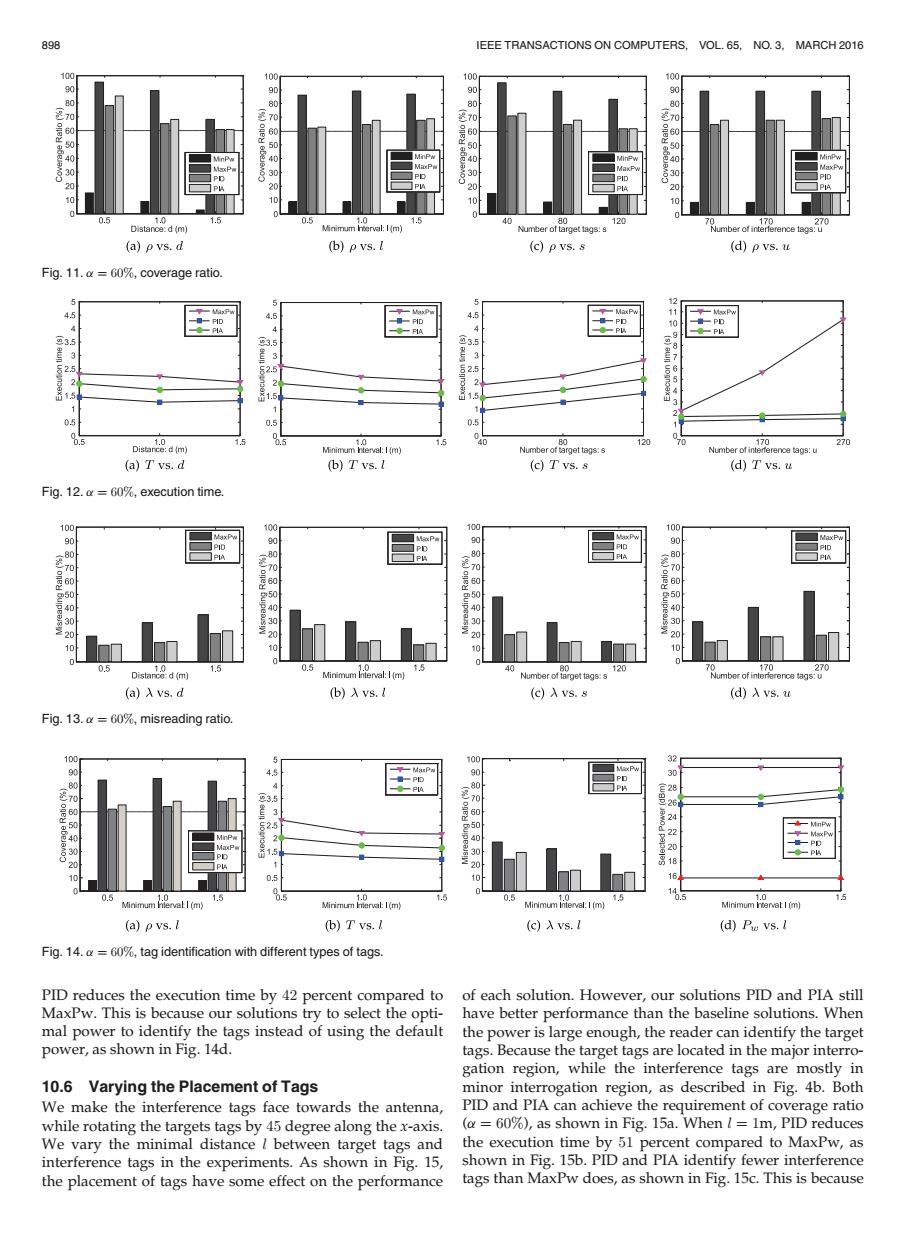正在加载图片...

898 IEEE TRANSACTIONS ON COMPUTERS,VOL.65,NO.3.MARCH 2016 100 10 100 100 90 90 90 00 70 60 3 00 30 2 0 10 10 10 0.5 id (m) 05 nm:1(m) 120 (a)pvs.d (b)p vs.l (c)p vs.s (d)p vs.u Fig.11.a =60%,coverage ratio. 45 . 1 10 3.5 035 525 52.5 2 1.5 25 1 11 05 0.5 Distarc品dm nimm evl:(m) 5 Number of 120 20 (a)T vs.d (b)T vs.I (c)T vs.s (d)T vs.u Fig.12.o 60%,execution time. 00 100 90 0 90 70 8 60 8 40 30 0.5 15 0.5 Minmumel:(m) 5 40 120 (a)λvs.d (b)入vs.l (c)λvs.s (d)入vs.u Fig.13.a =60%,misreading ratio. 100 00 45 Ma Pw 90 30 8 23.5 82 3 号60 52 50 24 MnPW -PD 30 20 高18 16 0.5 Minimum htervell(m) 1.3 Mirimum品enat:1(m) 0.5 Minimum intervel:I(m) 15 Minimum itervaLI(m) (a)pvs.I (b)T vs.I (c)入vs.I (d)Pe vs.I Fig.14.=60%,tag identification with different types of tags. PID reduces the execution time by 42 percent compared to of each solution.However,our solutions PID and PIA still MaxPw.This is because our solutions try to select the opti- have better performance than the baseline solutions.When mal power to identify the tags instead of using the default the power is large enough,the reader can identify the target power,as shown in Fig.14d. tags.Because the target tags are located in the major interro- gation region,while the interference tags are mostly in 10.6 Varying the Placement of Tags minor interrogation region,as described in Fig.4b.Both We make the interference tags face towards the antenna, PID and PIA can achieve the requirement of coverage ratio while rotating the targets tags by 45 degree along the x-axis. (a 60%),as shown in Fig.15a.When l 1m,PID reduces We vary the minimal distance l between target tags and the execution time by 51 percent compared to MaxPw,as interference tags in the experiments.As shown in Fig.15, shown in Fig.15b.PID and PIA identify fewer interference the placement of tags have some effect on the performance tags than MaxPw does,as shown in Fig.15c.This is becausePID reduces the execution time by 42 percent compared to MaxPw. This is because our solutions try to select the optimal power to identify the tags instead of using the default power, as shown in Fig. 14d. 10.6 Varying the Placement of Tags We make the interference tags face towards the antenna, while rotating the targets tags by 45 degree along the x-axis. We vary the minimal distance l between target tags and interference tags in the experiments. As shown in Fig. 15, the placement of tags have some effect on the performance of each solution. However, our solutions PID and PIA still have better performance than the baseline solutions. When the power is large enough, the reader can identify the target tags. Because the target tags are located in the major interrogation region, while the interference tags are mostly in minor interrogation region, as described in Fig. 4b. Both PID and PIA can achieve the requirement of coverage ratio (a ¼ 60%), as shown in Fig. 15a. When l ¼ 1m, PID reduces the execution time by 51 percent compared to MaxPw, as shown in Fig. 15b. PID and PIA identify fewer interference tags than MaxPw does, as shown in Fig. 15c. This is because Fig. 11. a ¼ 60%, coverage ratio. Fig. 12. a ¼ 60%, execution time. Fig. 13. a ¼ 60%, misreading ratio. Fig. 14. a ¼ 60%, tag identification with different types of tags. 898 IEEE TRANSACTIONS ON COMPUTERS, VOL. 65, NO. 3, MARCH 2016